Kfz.15 (Horch 901)
 Germany (1934-45) - Staff Car
Germany (1934-45) - Staff Car
Mittlerer Geländegängiger Pkw. 19,800 built
The Horch 901 was a medium-sized all-terrain staff car of the Wehrmacht. It was developed from 1935 and along 1936 according to Army specifications from the waffenamt, which latter attributed the Kfz.15 designation. Specifications included independent wheel suspension, all-wheel drive. Produced successively by Horch, and Open, to a total of over 19,800 vehicle, the Horch 901 became the staple vehicle from moderate to high ranking officers of the Werhmacht. Being an off-road vehicle, it was on every front of WW2 on the German side. It was well-appreciated as being infinitely more comfy, spacious and powerful compared to the puny
Kübelwagen from VW (Type 82) of which twice more were built. In fact the Horch 901 ws also a "Kübelwagen" according to its official bodywork designation. From 1943 however production was discontinued as the more versatile Mercedes-Benz L 1500 S/A and the Steyr 1500 A with a higher payload were proferred. The Horch 901 never had a direct successor and the vehicles were used until 1945, albeit in simplified versions.
Design development 1935-37
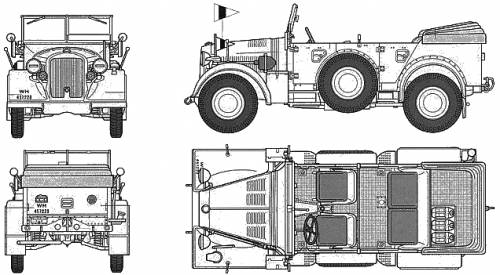
The prototype retained for production was the one from Auto Union's Horch plant in Zwickau. After approval in 1936, production started in 1937 and went on until 1943 with 14,911 vehicles delivered. They were proposed with two V8 engines: The Horch 80 hp (59 kW) 3.5 liters borrowed from the 830/930 civilian car and in the later production in 1940-43, a 3.8 liter 90 hp (66 kW) engine.
The Auto-Union Group's Siegmar plant, formerly Wanderer, manufactured around 16,000 vehicles, named "Wanderer 901", still with Horch V8 engines but also the less powereful 6-cylinder in-line 75 hp (55 kW) Opel Blitz model. Between 1938 and 1943, the Opel factory in Brandenburg manufactured at least 3,860 medium-duty standard passenger cars with Opel six-cylinder engines under license.
About Horch
August Horch created his first business with his partner Salli Herz on November 14, 1899 in Ehrenfeld, Cologne. Horch came before that from Karl Benz, as production manager. By 1902, he moved to Reichenbach im Vogtland and by 1904 founded Horch & Cie. Motorwagenwerke AG in Zwickau. Later here on 16 July 1909, August Horch Automobilwerke GmbH in Zwickau was founded, which soon became the main plant. It was on 25 April 1910 renamed "Audi Automobilwerke". In 1932 both companies from Zwickau, Horch and Audi, merged into Zschopauer Motorenwerke J. S. Rasmussen (DKW) while the Wanderer car-production facilities became Auto Union.
The line evolved with the engines. The first open models were study and had good quality, and by 1904, August Horch developed its first six-cylinder engine and the company was promoted worldwide by Moritz Stauss, a cosmopolitan Berliner. Her became its principal stockholder and made the Horch brand highly desirable by using talented artist for its advertising. In 1923, Paul Daimler (a Stauss associate) worked for Horch as chief engineer and created the first 8-cylinder engines. Due to the large engine, the company veered clearly towards luxury cars, more profitable, and became a competitor for Mercedes and Maybach.
Since the market of
luxury cabriolet became soon its trademark, Horch introduced its flagship, the Model 670, first 12-cylinder luxury cabriolet the same year of 1932. But that same year, the company also fusioned with Audi, Wanderer, DKW to form Auto-Union and Horch became it's luxury branch. The brand was also soon famous due to racing, starting rivalling Alfa Romeo, Daimler and Bugatti. Grand Prix with types A to D were developed by the dedicated racing department at Horch works in Zwickau. Until 1937 25 races were won, with pilots such as Ernst von Delius, Tazio Nuvolari, Bernd Rosemeyer, Hans Stuck and Achille Varzi.
Of course soon Auto-Union started to provide the rebuilt Wehrmacht since 1933. It soon provided the Heavy standard passenger car Horch 108, and its Medium standard passenger car Horch/Wanderer 901 with in addition the
Sd.Kfz.11. Civilian production was suspended after March 1940. In 1943-44 Zwickau factories were bombed to oblivion and the production line of the Horch 901 was stopped completely. Amidst dwindling resources and labor shortages, and Speer's urge for simplification and concentration proper to a war economy, the Waffenamt decided to discontinue it.
In 1945 advancing Soviet forces captured the area and somle of the resources were reused in DKW while in East Germany. Audi was revived in 1964 but Daimler-Benz retained the trademark rights to the Horch brand until the mid 1980s and transferred them to Audi, but it remained dorman ever since.
Design of the Horch 901
The Mittlerer Geländegängiger Pkw ("Medium 4x4 multirole vehicle") was a large, but conventional model with a ladder-type chassis and an open bodywork of the "bucket-type" hence the name of "Kübelwagen". Yet it was completely overhadowed by the VW 82 and thus, often called Kfz.15 or "Horch 901", or "Horch Car". The Wandered models were soon assimilated.
Compared to the VW 82 it was more complicated to manufacture and much heavier and larger. It was not at ease on mud unlike the VW model, but could reach greater speed on the right roads or flat terrain and was more sturdy overall.
A spare wheel was attached on both sides and the doors opened over the well. But they also could serve as support wheel or third central axle when driving over rough terrain, soft surface or small walls. It was the genious stroke from Horch which won the orders.
From 1940 onwards however for simplification these were eliminated (Type 40) and instead, a single spare wheel was stowed on the trunk, offering more internal space. The Type 40 was also given the 3.8 liter 90 hp (66 kW), Lighter than the previous one, it was faster and even more appreciated. It was not uncommon to see such vehicle reach 100 kph on an autobahn, used by the staff while in Germany.
Main variants
Horch 901 (Kfz.15)
Basic production version with the third wheel axis in the center and the 80 hp 8.5 Liters engine.
Wanderer 901 (Kfz.15)
Basically same vehicle with Horch engine, but sligthly different bodywork and Wandered chassis.
Horch Type 40 (Kfz.15)
Revised and simplfied version produced 1940-43, without the middle third axis and dfferent trunk.
- 15 Funkkraftwagen: radio car
- 15 Nachrichtenkraftwagen: signals car (formerly designated telephone car)
- 15 Fernschreibkraftwagen: telex car (introduced most probably in 1943)
- 15 Fernschreibanschlußkraftwagen: telex connection car (introduced most probably in 1943)
- 15 Fernsprechkraftwagen: telephone car (introduced most probably in 1943)
- 15/1 Nachrichtenkraftwagen signals car (deleted with AHM 198, 1938)
- 15/2 Funkkraftwagen radio car (deleted, same)
- 15/3 Funkkraftwagen radio car (same)
- 15/4 Funkkraftwagen radio car (same)
- 15/5 Funkkraftwagen radio car (same)
- 15/6 Funkkraftwagen radio car (same)
- 15/7 Funkkraftwagen //
Nachrichtenkraftwagen (Kfz. 15)
This was the standard signals motor vehicle variant. It was abbreviated Nachr.Kw.(Kfz. 15) mit Fahrgestell des m.Pkw.(o) of with the medium passenger car (commercial) chassis. It was based on the Horch (830 R) and also based on the Stoewer (M 12 RW) and Wanderer (W 11 10/50 PS, W 11 12/60 PS). It had a large equipment box at the rear with mountings for a carrying frame on the front mudguards.
Funkkraftwagen (Kfz. 15)
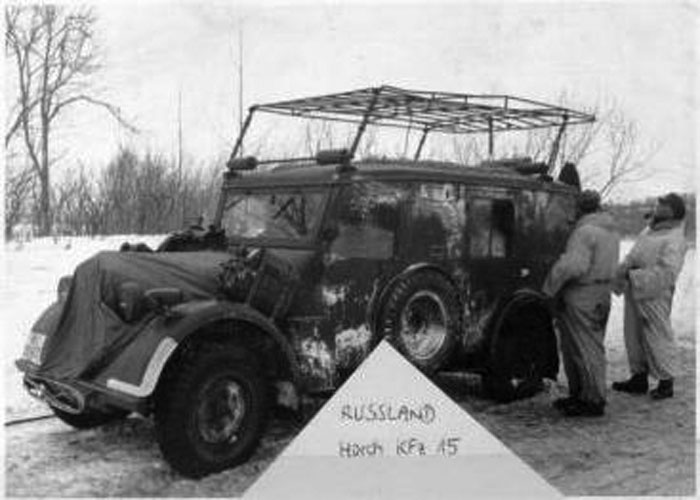
Standard radio command vehicle. Lit. the "radio motor vehicle - (Kfz. 15)" it was also abbreviated Fu. Kw. (Kfz. 15). It was the equivalent for the m.gl.Pkw.(Kfz. 12). Most were delivered with the late standard chassis, called Einheitsfahrgestells für m. Pkw. ("standard chassis for medium passenger car") as well as the Typ 40 chassis. Production records are unknown.
Mittlerer Meßtruppkraftwagen (Kfz. 16)
http://www.kfzderwehrmacht.de/Homepage_english/Miscellaneous/Kfz-Numbers/Kfz__Numbers/Kfz__16_m_Messtr_Kw_/kfz__16_m_messtr_kw_.html
Vorwarnerkraftwagen (Kfz. 16/1)
Fernsprechbetriebskraftwagen (Kfz. 17)
The telephone operating motor vehicle, abbreviated Fsp. Betr. Kw. (Kfz. 17), mit Einheitsfahrgestell für m. Pkw. It used the standard Typ 40 chassis. It was the smallest variant, and it can easily be differentiated from others by its "Klappleiter" or folding ladder and three "Erdleitungsrohre" or earth conductor tubes plus its "Abspannleiste" or marshalling panel as regular features.
Kommandeurskabriolett Horch 901
A dedicated, short serie VIP version for high ranking generals, with specific amenities and onboard radio.
Kfz. 17
A full enclosed body vehicle, with variations. Declined into 12 specialized sub-variants: The Fernsprechbetriebskraftwagen, Funkkraftwagen, Kabelmeßkraftwagen, Rundfunkaufnahmekraftwagen, kleiner Lautsprecherkraftwagen, Verstärkerkraftwagen, großes Wehrgeologengerät and Funkkraftwagen 17/1, the 17/2 kleiner Fernsprechtruppkraftwagen and 17/3 kleiner Funkkraftwagen (Bezeichnung vermutlich gestrichen) versions.
Kfz. 12
A tractor vehicle based on the Horch 901, used by antitank crews.
The Kfz.15 in combat
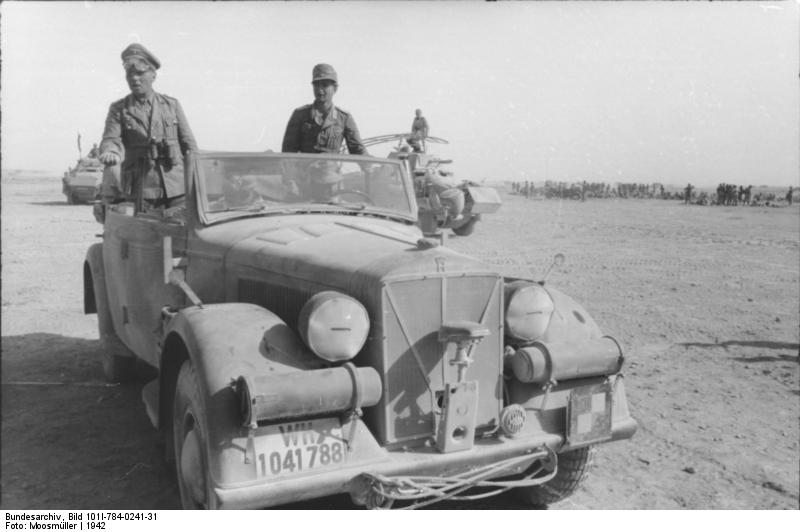 Erwin Rommel in North Africa wit his Horch 901
Erwin Rommel in North Africa wit his Horch 901
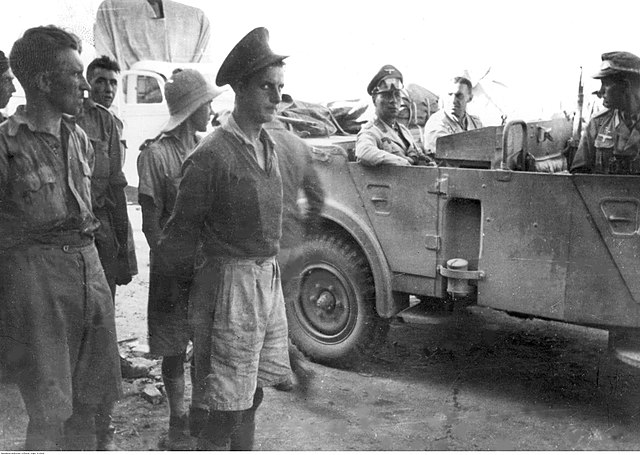 Rommel visiting an Australian POW camp in Tobruk
Rommel visiting an Australian POW camp in Tobruk
The Horch 901 in its Kz.15 form was mainly a staff car at
regimental level, present to carry Regimental officers to individual Batallions, then platoons and companies. Each had a HQ and each was equipped either by the VW Küberwagen (Companies and Platoons) and at high level, Batallion and at the Regiment HQ level, a park of Kfz.15 for staff transport alone.
As seen above, each regiment had its own park of specialized vehicles and variants. Especially important were the signals and radio vehicles. Of course those at Regimental level had ones with the heaviest radio equipment, for long range communication to Division HQ. At Batallion level, vehicles carried variants with shorter range radios to communicate to the Regimental HQ, and vehicles to communicate at Company level.
 Rommel helping his crew bogged down his Kfz.15
Rommel helping his crew bogged down his Kfz.15
At Division HQ level, these vehicles were also used, but especially the Kommandeurskabriolett Horch 901 for VIPs, generals and high ranking colonels.
Nevertheless The Romanian Army purchased 300 Horch 901 4x4 field cars to mechanize some of its anti-tank companies.
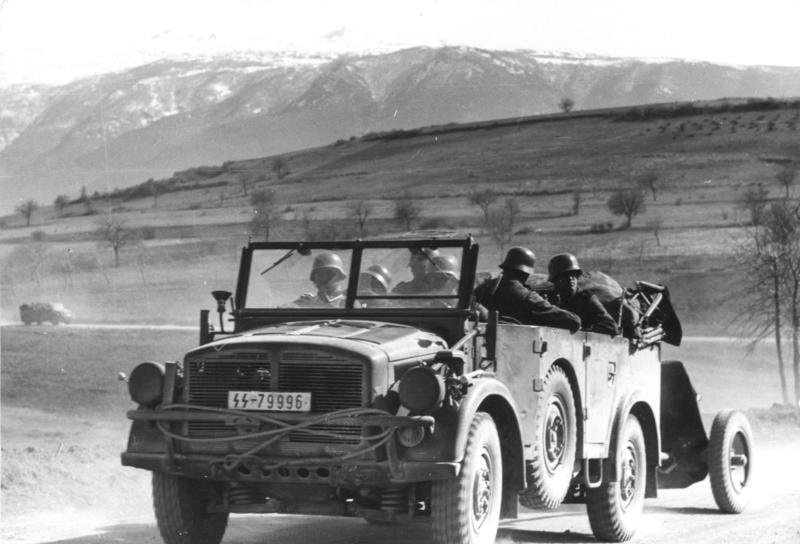 The other Kfz.15, the larger Horch 108. Lebsrandarte Adolf Hitler, Balkans May 1941.
The other Kfz.15, the larger Horch 108. Lebsrandarte Adolf Hitler, Balkans May 1941.
Links/Src about the Sd.Kfz.11
Books
Werner Oswald: Alle Horch Automobile 1900–1945. 1. Auflage, Motorbuch Verlag, Stuttgart 1979
Werner Oswald: Kraftfahrzeuge und Panzer der Reichswehr, Wehrmacht und Bundeswehr, Motorbuch Verlag, Stuttgart 1982
Der Mittlere Einheits-Pkw der Deutschen Wehrmacht 1937-1945 Dr. Hans-Georg Mayer-Stein - Waffen-Arsenal Nr. 157
Links
On fahrzeuge-der-wehrmacht.de
German infantry regiments
archive.armorama.com
The wanderer 901 on milweb.net
Horch wiki
common
Flickr Rommel's car
kfzderwehrmacht.de Nachrichtenkraftwagen (Kfz. 15)
kfzderwehrmacht.de Kfz__15_Fu
lexikon-der-wehrmacht.de
4legend.com
On scalemates.com
Horch query on scalemates.com
Mittlerer Geländegängiger Pkw query on scalemates.com
Tamiya's 1:35 Afrika Korps kit
Italery kit, same scale
Hanomag Sd.Kfz.11 specifications |
| Dimensions | 4.75 m (15 ft 6 in) x 1.93 m (6 ft 3 in) x 2 m (6 ft 6 in) |
| Total weight, battle ready | 3,400 kg (7,500 lb) |
| Crew | 2 (driver, co-driver) + 8 troops |
| Propulsion | Maybach HL42 TRKM 4.2L 6-cyl. water-cooled petrol 99 hp |
| Top speed | 65/25 km/h (40/16 mph) road/off-road |
| Payload | 1,250 kg (2,650 lb) |
| Transmission | 7 + 3 speed Maybach Variorex SRG 102128H |
| Suspension | Torsion Bars |
| Maximum range (on/off road) | 300/150 km (190/93 mi) |
| Armament | None, see notes |
| Armor | 6 mm (0.2 in) |
| Production | Hanomag, 1938–1945 - 22,000 Reichmark |